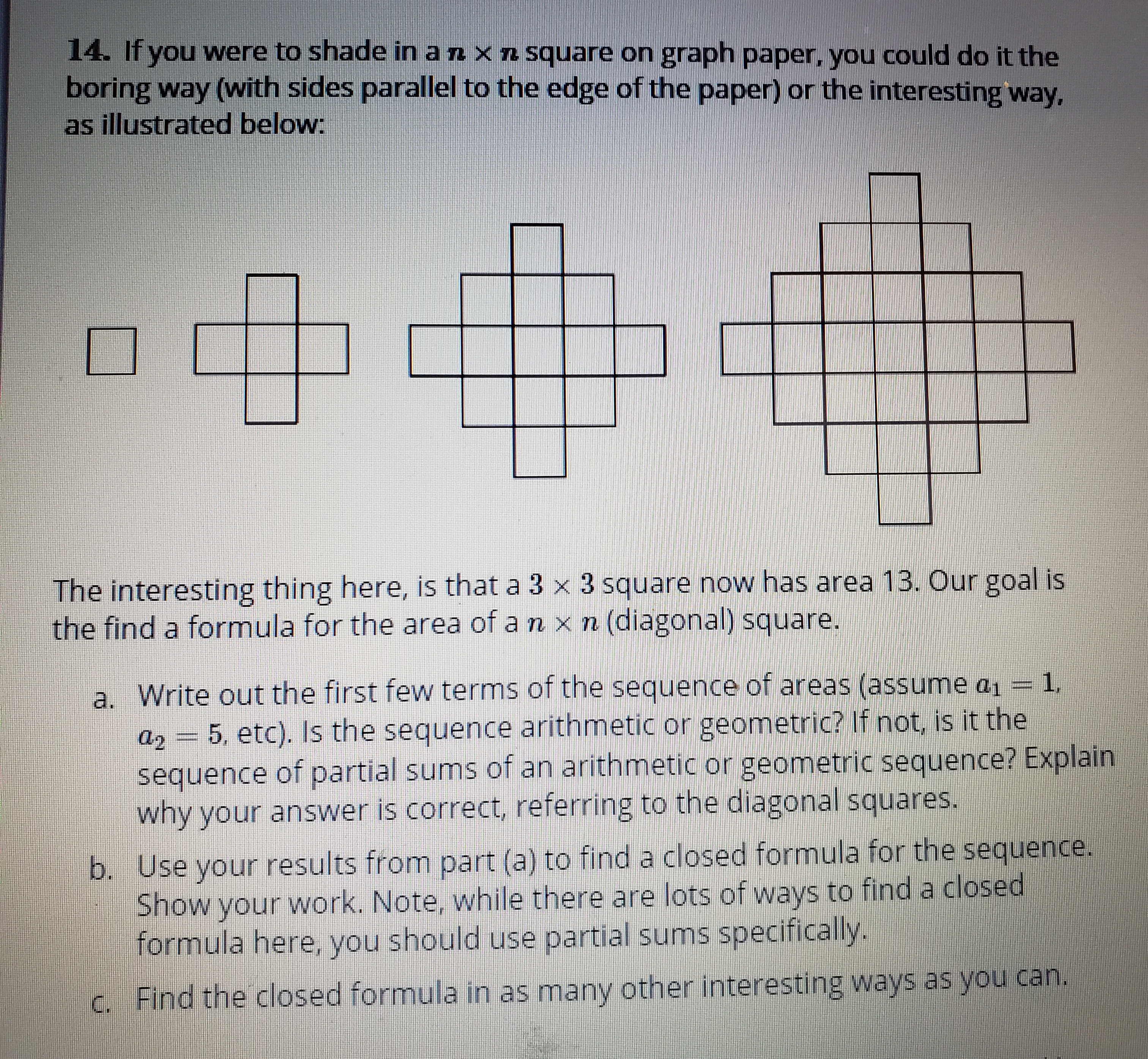14. If you were to shade in a nxn square on graph paper, you could do it the boring way (with sides parallel to the edge of the paper) or the interesting way, as illustrated below: The interesting thing here, is that a 3 x 3 square now has area 13. Our goal is the find a formula for the area of a n x n (diagonal) square. a. Write out the first few terms of the sequence of areas (assume a1 = 1, a2 = 5, etc). Is the sequence arithmetic or geometric? If not, is it the sequence of partial sums of an arithmetic or geometric sequence? Explain why your answer is correct, referring to the diagonal squares. b. Use your results from part (a) to find a closed formula for the sequence. Show your work. Note, while there are lots of ways to find a closed formula here, you should use partial sums specifically. C. Find the closed formula in as many other interesting ways as you can.
14. If you were to shade in a nxn square on graph paper, you could do it the boring way (with sides parallel to the edge of the paper) or the interesting way, as illustrated below: The interesting thing here, is that a 3 x 3 square now has area 13. Our goal is the find a formula for the area of a n x n (diagonal) square. a. Write out the first few terms of the sequence of areas (assume a1 = 1, a2 = 5, etc). Is the sequence arithmetic or geometric? If not, is it the sequence of partial sums of an arithmetic or geometric sequence? Explain why your answer is correct, referring to the diagonal squares. b. Use your results from part (a) to find a closed formula for the sequence. Show your work. Note, while there are lots of ways to find a closed formula here, you should use partial sums specifically. C. Find the closed formula in as many other interesting ways as you can.
College Algebra (MindTap Course List)
12th Edition
ISBN:9781305652231
Author:R. David Gustafson, Jeff Hughes
Publisher:R. David Gustafson, Jeff Hughes
Chapter8: Sequences, Series, And Probability
Section8.2: Sequences, Series And Summation Notation
Problem 40E: Find the sum of the first five terms of the sequence with the given general term. an=2n+1
Related questions
Question

Transcribed Image Text:14. If you were to shade in a nxn square on graph paper, you could do it the
boring way (with sides parallel to the edge of the paper) or the interesting way,
as illustrated below:
The interesting thing here, is that a 3 x 3 square now has area 13. Our goal is
the find a formula for the area of a n x n (diagonal) square.
a. Write out the first few terms of the sequence of areas (assume a1 = 1,
a2 = 5, etc). Is the sequence arithmetic or geometric? If not, is it the
sequence of partial sums of an arithmetic or geometric sequence? Explain
why your answer is correct, referring to the diagonal squares.
b. Use your results from part (a) to find a closed formula for the sequence.
Show your work. Note, while there are lots of ways to find a closed
formula here, you should use partial sums specifically.
C. Find the closed formula in as many other interesting ways as you can.
Expert Solution
This question has been solved!
Explore an expertly crafted, step-by-step solution for a thorough understanding of key concepts.
This is a popular solution!
Trending now
This is a popular solution!
Step by step
Solved in 5 steps with 10 images

Recommended textbooks for you

College Algebra (MindTap Course List)
Algebra
ISBN:
9781305652231
Author:
R. David Gustafson, Jeff Hughes
Publisher:
Cengage Learning

College Algebra (MindTap Course List)
Algebra
ISBN:
9781305652231
Author:
R. David Gustafson, Jeff Hughes
Publisher:
Cengage Learning